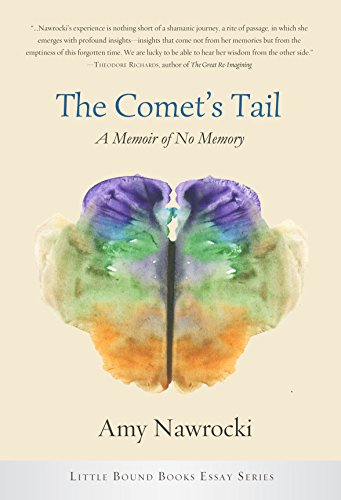The Comet’s Tail
The Comet’s Tail is a book about memory, the lack of memory, and the slow and painstaking process of recreating life and meaning after a coma.
The Comet’s Tail is a book about memory, the lack of memory, and the slow and painstaking process of recreating life and meaning after a coma.
The summer after Amy Nawrocki’s first year of college, she contracted a mysterious disease—possibly a form of encephalitis, she later learns—and went into a coma. She stayed in that state for several months, while doctors, family, friends, and the rest of the world swirled around her.
In this small book—which is really a long essay, part of Homebound Publications’s new series called Little Bound Books—Nawrocki attempts to reconstruct what happened before, during, and after this coma, and in the process, she’s written a meditation about the mysteries of memory itself.
The subtitle of this book, “A Memoir of No Memory,” is ironic, given that memoir is a genre that’s all about memory, and in fact, the two words share etymological roots. We generally assume that a memoir will be based on memories however imperfect they might be, but Nawrocki has no memory of being in the coma, and only limited memories of events before and after it.
Nawrocki’s task in this book, therefore, is to tell a story based on fragments: bits and pieces from her journals, medical records, and the memories and accounts of others. These fragments necessarily tell an incomplete story, but they’re all she has, so she stitches them, quilt-like, together.
The book starts with a catalogue of her pre-coma memories:
These are the things I do remember: I do remember driving home on lightless highways from my summer job in New Haven, windows half-rolled, thick June air blowing around me. I do remember emptying my bank account to buy a fish tank for fish that died. I remember falling asleep to James Brown and recordings of electrical thunderstorms.
Right after this list, however, she lists the memories she doesn’t have:
I do not remember dread or panic. I do not remember seizures, quivering like a wind-up toy let loose from its coil. I do not remember the tubes, the tests, or the icy cold of space. I do not remember losing six months of my life.
These memories and un-memories push against each other throughout the text, the tension between them driving the narrative and forming some of the book’s most vital and memorable moments.
To create a coherent story, Nawrocki tries to recreate as much of what happened as possible, while admitting that there’s much missing from her tale. It’s a constant dance between what’s present and what’s absent. And the absences, like the many white spaces between sections in the book, speak as powerfully as anything that’s actually there.
Early in the book, Nawrocki asks, “How can I write a memoir about events for which I have no memory?” And this, in fact, becomes the central question of the text, one that only finds its answer in the spaces between and around known facts.
The Comet’s Tail, in this sense, is a narrative about narrative. It asks what we—as writers and readers—expect from narrative, and whether we can have a narrative that makes sense if we’re missing key facts, details, and even authorial awareness. Nawrocki is a self-proclaimed unreliable narrator, and the text she’s written interrogates the depth and breadth of that unreliability.
Woven throughout the book are images of space, the universe, and comets. At one point, Nawrocki describes the process of using her journals to reconstruct what happened before her coma:
I would find the journal and that old self again, but it would be a long, strange while before I did. Across an open sky, the comet’s tail disappears into dust. We may read in the particles proof of existence.
In other words, we see and understand a comet by what it leaves behind, by the fragments of its own dust. In this way, too, she recreates her own celestial journey.
Later, post-coma, she returns to the image of a comet:
As a comet propels through the invisible ellipse, closer and closer and closer to the sun, the cloudy halo that rings the icy nucleus begins to burn up. Blown by solar winds, the coma’s fuzzy granules and evaporating ice extend as a long tail of ions and dust across the sky. Evaporation lasted another three months. Waking up took as long as sleeping.
It’s a powerful image, in part because a comet is a thing of beauty and mystery—much like Nawrocki’s coma itself. And the linguistic echo between “comet” and “coma” has a poetic power and resonance that travels the length and breadth of this book’s ink-dark universe.





